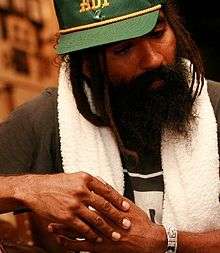Gonjasufi
| Gonjasufi | |
|---|---|
 | |
| Background information | |
| Birth name | Sumach Ecks |
| Also known as | Sumach Valentine, |
| Origin | San Diego, California, United States |
| Genres | Experimental, lo-fi, alternative hip hop, psychedelic rock, trip hop, dub |
| Occupation(s) | Vocalist, producer, DJ, actor, yoga teacher |
| Instruments | vocals, turntables |
| Years active | 1990s–present |
| Labels | Warp, A.I.R., Hit + Run |
| Associated acts | Flying Lotus, The Gaslamp Killer |
| Website |
www |
Sumach Ecks[1] (born 1978),[2] better known by his stage name Gonjasufi, is an American vocalist, producer, disc jockey, actor and yoga teacher.[3]
Life and career
Ecks was born in 1978 to a Mexican mother and an American-Ethiopian father.[1] He spent his formative years in Chula Vista, California.[4]
Ecks got involved early on in the arts, playing Helios the Sun God in the opera Persephone.[5]
In the early 1990s, he began releasing music within the San Diego hip hop scene; notably with the Masters of the Universe crew.[6][7] Touring under the stage names Sumach Valentine and Randy Johnson,[6] his first band was called Plant Lyphe.[5]
Ecks gained notice from Warp Records in 2008 after an appearance on Californian musician Flying Lotus' album Los Angeles, on which he sings on the track "Testament".[7] His Warp debut album, A Sufi and a Killer, was released on March 8, 2010.[8]
Ecks' voice has been described by Pitchfork Media as "a scraggly, scary, smoked-out croak that creeps like the spiritual offspring of George Clinton and Lead Belly."[7] He attributes his singing style to his day job teaching yoga, where he was forced to learn how to "project from [his] stomach more".[7] His music is largely experimental, fusing urban beats with psychedelic flourishes.[9][10]
Besides singing and rapping,[11] Ecks also serves as a producer,[12] DJ,[13] actor,[14] and yoga teacher.[4]
Discography
Studio albums
- A Sufi and a Killer (2010)
- MU.ZZ.LE (2012)
- Callus (2016)
Remix albums
- The Caliph's Tea Party (2010)
EPs
- The Ninth Inning EP (2011)
- Untitled (2013) (split with Ras G)
Singles
- "Holidays" b/w "Candylane" (2009)
- "Kowboyz&Indians" b/w "My Only Friend" (2010)
- "Kobwebz" b/w "Speaketh" (2010)
- "Nickles and Dimes" (2010)
- "Ninth Inning" (2011)
- "The Blame" (2012)
Guest appearances
- Flying Lotus - "Testament" from Los Angeles (2008)
- The Gaslamp Killer - "I’m in Awe" from Death Gate (2010)
- Humansuit - "Lawnmower Man" from Humansuit (2012)
- The Gaslamp Killer - "Veins" and "Apparitions" from Breakthrough (2012)
- Old English - "The Omen" from Band in Amerikkka (2013)
- Perera Elsewhere - "Giddy" from Everlast (2013)
- Awol One & Gel Roc - "Flight" from The Cloaks (2014)
- Dag Savage - "Bad Trip" from E & J (2014)
- The Bug - "Save Me" from Angels & Devils (2014)
References
- 1 2 Meer, Malik (March 6, 2010). "Gonjasufi – the electro Hendrix". The Guardian. Retrieved July 4, 2010.
- ↑ Green, Thomas H. (January 14, 2012). "theartsdesk Q&A: Musician Gonjasufi". The Arts Desk. Retrieved April 15, 2015.
- ↑ SDR - Gonjasufi Extended Interview
- 1 2 Deal, Chad (January 20, 2012). "Gonjasufi Extended Interview". San Diego Reader. Retrieved April 15, 2015.
- 1 2 Gimme5 Interview: Gonjasufi Archived March 8, 2010, at the Wayback Machine.
- 1 2 Lymangrover, Jason. "Gonjasufi Biography". AllMusic. Retrieved March 8, 2010.
- 1 2 3 4 Dombal, Ryan (February 25, 2010). "Rising: Gonjasufi". Pitchfork Media. Retrieved March 6, 2010.
- ↑ Hogwood, Ben (March 8, 2010). "Gonjasufi – A Sufi And A Killer". MusicOMH. Retrieved April 15, 2015.
- ↑ Dacks, David (May 13, 2010). "Gonjasufi: A Sufi And A Killer". Exclaim!. Retrieved April 15, 2015.
- ↑ Fantano, Anthony (June 8, 2010). "Gonjasufi: Musings Of A Hip-Hop Mystic". NPR. Retrieved April 15, 2015.
- ↑ Olshevski, Andrew (November 2, 2011). "New Mini-Album From Gonjasufi". CMJ. Retrieved April 15, 2015.
- ↑ Roberts, Randall (February 21, 2012). "Video premiere: Gonjasufi roams downtown L.A.". Los Angeles Times. Retrieved April 15, 2015.
- ↑ Pressman, Joshua (March 15, 2010). "Tonight In Rock: She & Him, Gonjasufi, Moonrats, The Delta Mirror". LAist. Retrieved April 15, 2015.
- ↑ "The Cure star legally changes his name as he leaves the music world for art". Hollywood.com. March 15, 2015. Retrieved April 15, 2015.
External links
- Official website
- Gonjasufi discography at Discogs